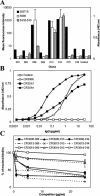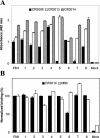Molecular and biological characterization of human monoclonal antibodies binding to the spike and nucleocapsid proteins of severe acute respiratory syndrome coronavirus
- PMID: 15650189
- PMCID: PMC544131
- DOI: 10.1128/JVI.79.3.1635-1644.2005
Molecular and biological characterization of human monoclonal antibodies binding to the spike and nucleocapsid proteins of severe acute respiratory syndrome coronavirus
Abstract
Human monoclonal antibodies (MAbs) were selected from semisynthetic antibody phage display libraries by using whole irradiated severe acute respiratory syndrome (SARS) coronavirus (CoV) virions as target. We identified eight human MAbs binding to virus and infected cells, six of which could be mapped to two SARS-CoV structural proteins: the nucleocapsid (N) and spike (S) proteins. Two MAbs reacted with N protein. One of the N protein MAbs recognized a linear epitope conserved between all published human and animal SARS-CoV isolates, and the other bound to a nonlinear N epitope. These two N MAbs did not compete for binding to SARS-CoV. Four MAbs reacted with the S glycoprotein, and three of these MAbs neutralized SARS-CoV in vitro. All three neutralizing anti-S MAbs bound a recombinant S1 fragment comprising residues 318 to 510, a region previously identified as the SARS-CoV S receptor binding domain; the nonneutralizing MAb did not. Two strongly neutralizing anti-S1 MAbs blocked the binding of a recombinant S fragment (residues 1 to 565) to SARS-CoV-susceptible Vero cells completely, whereas a poorly neutralizing S1 MAb blocked binding only partially. The MAb ability to block S1-receptor binding and the level of neutralization of the two strongly neutralizing S1 MAbs correlated with the binding affinity to the S1 domain. Finally, epitope mapping, using recombinant S fragments (residues 318 to 510) containing naturally occurring mutations, revealed the importance of residue N479 for the binding of the most potent neutralizing MAb, CR3014. The complete set of SARS-CoV MAbs described here may be useful for diagnosis, chemoprophylaxis, and therapy of SARS-CoV infection and disease.
Figures









References
-
- Biel, S. S., and H. R. Gelderblom. 1999. Electron microscopy of viruses, p. 111-147. In A. Cann (ed.), Virus cell culture: a practical approach. Oxford University Press, Oxford, England.
-
- Boel, E., S. Verlaan, M. J. Poppelier, N. A. Westerdaal, J. A. Van Strijp, and T. Logtenberg. 2000. Functional human monoclonal antibodies of all isotypes constructed from phage display library-derived single-chain Fv antibody fragments. J. Immunol. Methods 239:153-166. - PubMed
-
- Cavanagh, D., P. J. Davis, J. H. Darbyshire, and R. W. Peters. 1986. Coronavirus IBV: virus retaining spike glycopolypeptide S2 but not S1 is unable to induce virus-neutralizing or haemagglutination-inhibiting antibody, or induce chicken tracheal protection. J. Gen. Virol. 67(Pt. 7):1435-1442. - PubMed
MeSH terms
Substances
Associated data
- Actions
- Actions
- Actions
- Actions
- Actions
- Actions
- Actions
- Actions
- Actions
- Actions
- Actions
LinkOut - more resources
Full Text Sources
Other Literature Sources
Miscellaneous

